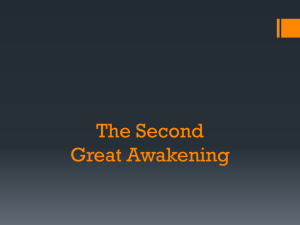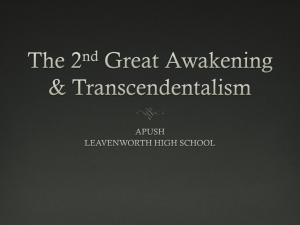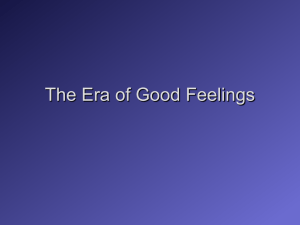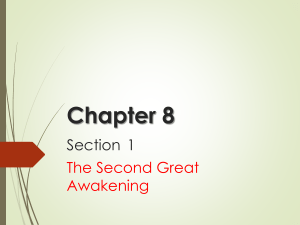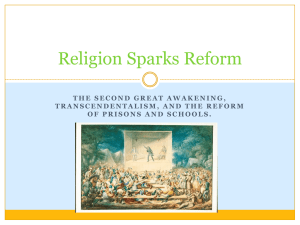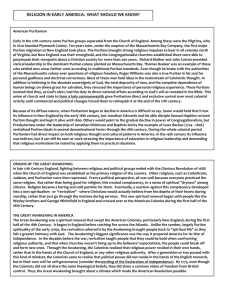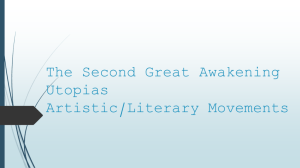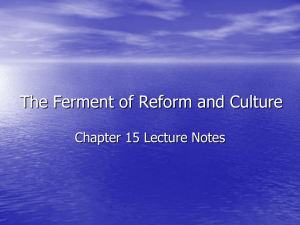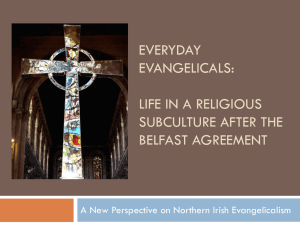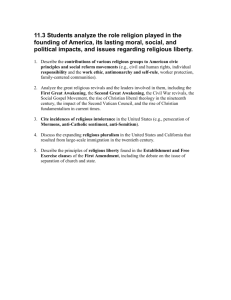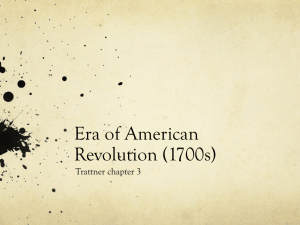Lecture Notes 3_3 - Second Great Awakening
advertisement
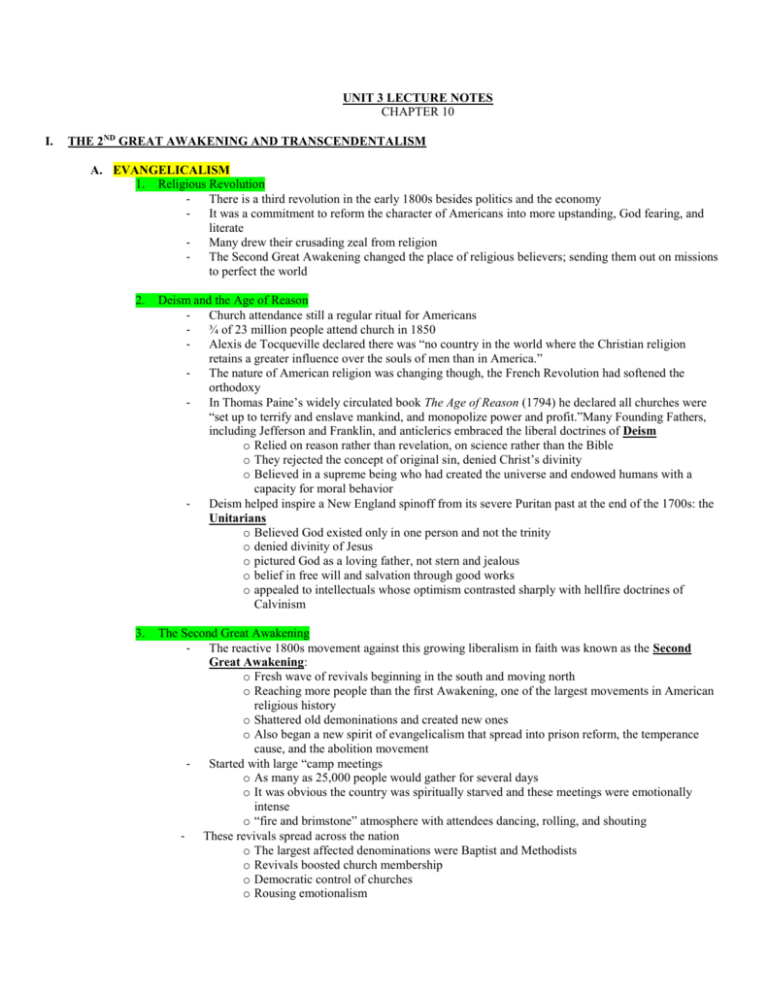
UNIT 3 LECTURE NOTES CHAPTER 10 I. THE 2ND GREAT AWAKENING AND TRANSCENDENTALISM A. EVANGELICALISM 1. Religious Revolution - There is a third revolution in the early 1800s besides politics and the economy - It was a commitment to reform the character of Americans into more upstanding, God fearing, and literate - Many drew their crusading zeal from religion - The Second Great Awakening changed the place of religious believers; sending them out on missions to perfect the world 2. Deism and the Age of Reason - Church attendance still a regular ritual for Americans - ¾ of 23 million people attend church in 1850 - Alexis de Tocqueville declared there was “no country in the world where the Christian religion retains a greater influence over the souls of men than in America.” - The nature of American religion was changing though, the French Revolution had softened the orthodoxy - In Thomas Paine’s widely circulated book The Age of Reason (1794) he declared all churches were “set up to terrify and enslave mankind, and monopolize power and profit.”Many Founding Fathers, including Jefferson and Franklin, and anticlerics embraced the liberal doctrines of Deism o Relied on reason rather than revelation, on science rather than the Bible o They rejected the concept of original sin, denied Christ’s divinity o Believed in a supreme being who had created the universe and endowed humans with a capacity for moral behavior - Deism helped inspire a New England spinoff from its severe Puritan past at the end of the 1700s: the Unitarians o Believed God existed only in one person and not the trinity o denied divinity of Jesus o pictured God as a loving father, not stern and jealous o belief in free will and salvation through good works o appealed to intellectuals whose optimism contrasted sharply with hellfire doctrines of Calvinism 3. The Second Great Awakening - The reactive 1800s movement against this growing liberalism in faith was known as the Second Great Awakening: o Fresh wave of revivals beginning in the south and moving north o Reaching more people than the first Awakening, one of the largest movements in American religious history o Shattered old demoninations and created new ones o Also began a new spirit of evangelicalism that spread into prison reform, the temperance cause, and the abolition movement - Started with large “camp meetings o As many as 25,000 people would gather for several days o It was obvious the country was spiritually starved and these meetings were emotionally intense o “fire and brimstone” atmosphere with attendees dancing, rolling, and shouting - These revivals spread across the nation o The largest affected denominations were Baptist and Methodists o Revivals boosted church membership o Democratic control of churches o Rousing emotionalism o Stressed personal conversion instead of predestination - Peter Cartwright o 1785 – 1872 o Methodist o Was a “circuit rider” or traveling frontier preacher o With strong emotional sermons called for sinners to repent - Charles Finney o Greatest revivalist preacher Trained as a lawyer Tall and athletic He held large captive audiences with powerful oratory and a smooth voice Focused on the NE in the early 1830’s Encouraged women to pray aloud in public Denounced alcohol and slavery o Finney’s Evangelicalism In the 1830s Charles Finney came to symbolize middle class evangelicalism Many began to ignore conservative old Puritan beliefs in their daily lives Benefits of the Market Revolution were the result of human effort So the middle class would soon become “moral free agents” allowed by God Valued individual holiness over permanent social order People could make the world better by choosing right over wrong You only had ability to choose right after submitting their rebellious wills to the will of God - Effects o Feminization of religion In terms of membership and theology Middle class women were the most fervent revival enthusiasts Were the wives and daughters of businessmen Evangelicals preached a gospel that appealed to them: female spiritual worth and the role of bringing their husbands back to God With that message many women turned their effort into saving the rest of society They formed charitable organizations and spearheaded many of the era’s reform movements B. OTHER RELIGIOUS MOVEMENTS 1. Burned-Over District - Revivals also fragmented religious faith in America - Many New England and New York citizens were exposed to so many revivals by the Awakening that Western New York became known as the Burned-Over District 2. Post Millennialists & Millerites - Plain protestants rarely talked about the millennium - Middle class evangelicals were post millennialists: they believed Christ’s second coming would occur at the end of 1,000 years of social perfection that would be brought about by missionary conversion of the world o Regular Baptists and Methodists believed that the millennium would arrive with worlddestroying violence, followed by 1,000 years of Christ’s rule - Millerites (Adventists) o At times, however, evangelicals predicted a fiery end of the world and encouraged people to look for end times signs o An example of this was William Miller a rural New York Baptist after years of study, concluded that God would destroy the world during the calendar year after March 1843 o This Millerite movement prepared for the end and March 23, 1844 came and went (October 22, 1844) o Most returned back to regular life, but some remained committed and eventually founded the seventh Day Adventist Church More prosperous eastern denominations were untouched by the Awakening - Presbyterians, Congregationalists, Unitarians - These were the more educated levels of society - The evangelistic fervor was strongest in less “learned” communities in rural south and west o 3. 4. THE SHAKERS - Seeking human betterment, many new “utopian” communities arose during the 1800s - They were communal in nature - Some organizations o New Harmony Founded by wealthy Scottish textile manufacturer Robert Owen 1825 in New Harmony, Indiana Eventually collapsed in contradiction o Brooke Farm Founded in 1841 in Mass. Small community that only lasted about a decade - Oneida o Founded in New York 1848 o Key to happiness is suppression of selfishness No private property No private relationships All of these breed jealousy and quarreling o Communal work according to skill o Practiced “free love” o Prospered due to steel and silver work - 5. The Shakers o Founded in England in 1747 o By Mother Ann Lee o Moved to upstate New York and by 1840 had a membership of 6,000 o Their monastic customs prohibited marriage and sexual relations o Virtually extinct by 1940 The Mormons - Founder of Mormonism: Joseph Smith o Smith’s father was a yeoman farmer without land, They rented o During his family struggles he has visions which lead to the creation of the Book of Mormon He founds the Church of Jesus Christ of Latter Day Saints in 1830 it created a patriarchal faith reported he received golden plates from an angel, when deciphered they constituted the book of mormon Smith ran into serious opposition throughout his life o His sect upset rank-and-file traditional American neighbors o In 1844 Smith and his brother were murdered by a mob in Carthage Illinois o The movement seemed near collapse o The leadership torch was picked up by Brigham Young o Determined to escape persecution he led the oppressed mormons to Utah in 1846-1847 o Through irrigation methods they made the Utah desert bloom and they became a populated and prosperous group o o o - C. TRANSCENDENTALISM 1. ROMANTICISM - In the first 30 years of American, citizens poured themselves into practical outlets and Americna writing was sneered and lampooned internationally - Much was plagiarized from Great Britain - After 1820 young American authors began to answer the call for authentic literature - Much was influenced by the arrival of Romanticism in America o Reaction against hyper-rational Enlightenment o Emphasized imagination over reason o Nature over civilization o Intuition over calculation o Self over society o Emotion, expression were core values - - 2. Washington Irving (1783 – 1859) o Born in NYC o First American writer to win international recognition o Knickerbocker’s History of New York o The Sketch Book The Legend of Sleepy Hollow Rip Van Winkle o Creative, humorous, local flavor James Fenimore Cooper (1789 – 1851) o Expelled from Yale o Married into wealthy family o Inspired to write by his wife o Many stories about Revolutionary Era o Contrasted wilderness with modern civ and intertwined with Native Americans o Last of the Mohicans (1826) TRANSCENDENTALISM - Golden Age of American literature - Began in New England in 1830’s o Rejected Locke empiricist theory – all knowledge comes to mind through senses o Truth “transcends” the senses, cannot be found by observation alone o Every person possesses an inner light o This inner light puts you in direct touch with God or the “Oversoul” o Did not have a precise definition o Upheld Individualism: in religion and social life o Self reliance, self culture, self discipline 3. - Ralph Waldo Emerson (1803 – 1882) o Tall, slender, Bostonian o Trained as a Unitarian minister o He stressed self reliance, self improvement, self confidence, optimism, and freedom o In “The America Scholar” speech at Harvard in 1837 he urged American writers throw off European traditions and delve into rich American tales o Many of his essays started as lectures o Essays: Nature, Self-Reliance - Henry David Thoreau (1817 – 1862) o Condemned a government that supported slavery o Refused to pay Mass. Poll tax and was jailed for a night o Walden: Or Life in the Woods(1854) Records two years of simple life spent in a hut that he built on Walden Pond in Concord Mass Favored quest for isolation in nature to get away from corruptions of society Get rid of society wants to pursue truth o Influenced Gandhi and MLK - Walt Whitman (1819 – 1892) o From Brooklyn – more bold, confident, swagger o Leaves of Grass (1855) Collection of poems Gave divinity to nature and human body Glorification of self All the past we leave behind; We debouch upon a newer, mightier world, varied world; Fresh and strong the world we seize – world of labor and the march – Pioneers! O Pioneers! LITERARY LIGHTS - Other great works were created during this age by literary giants who were not associated with transcendentalism - Professor Henry Wadsworth Longfellow (1807-1882) o Taught at Harvard o One of most popular American poets; popular in Europe as well o Had 2 wives tragically die; one was in front of him when her dress caught on fire o Evangeline (1847); The Song of Hiawatha (1855) - Louisa May Alcott (1832-1888) o Grew up in Concord, Mass. o Little Women (1868) - Emily Dickinson (1820-1886) o Grew up in Amherst, Mass. o Recluse poet o Simple language and rhyme schemes o Explored universal themes of love, death, nature, immortality - Dissenters There were also contrary writers who did not believe so keenly in human progress and goodness They explored darker realms of human experience with pain, fear, grief, and the supernatural o Edgar Allen Poe (1808-1849) Spent youth in Virginia Eccentric, genius Orphaned at an early age and often in ill health Married to a child-wife at age 13 who fell fatally ill to tuberculosis Suffered from hunger, cold, and poverty After failing at suicide he took refuge in poetry and short stories Specialized in gothic horror and detective stories The Raven (1845); The Murders in the Rue Morgue (1841) His career was cut short when found drunk in a Baltimore gutter; dying shortly after o Nathaniel Hawthorne (1804 – 1864) Lived in Salem, Mass. Grew up with the heavy atmosphere of Puritan ancestry The Scarlet Letter (1850) Puritan sin, romance o Herman Melville (1819 – 1891) Orphaned and ill-educated New Yorker Went to sea as a youth; served 18-months as a whaler Lived in the south seas with cannibals Moby Dick (1851) Novel of good and evil; told by narrator Ishmael Conflict between Captain Ahab and giant white whale Moby Dick Ahab loses his life in his maniacal pursuit of capturing Moby
